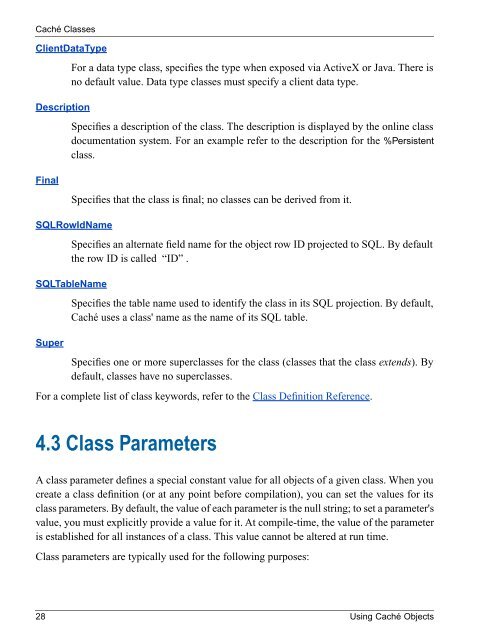Using Caché Objects - InterSystems Documentation
Using Caché Objects - InterSystems Documentation
Using Caché Objects - InterSystems Documentation
You also want an ePaper? Increase the reach of your titles
YUMPU automatically turns print PDFs into web optimized ePapers that Google loves.
<strong>Caché</strong> Classes<br />
ClientDataType<br />
Description<br />
For a data type class, specifies the type when exposed via ActiveX or Java. There is<br />
no default value. Data type classes must specify a client data type.<br />
Specifies a description of the class. The description is displayed by the online class<br />
documentation system. For an example refer to the description for the %Persistent<br />
class.<br />
Final<br />
Specifies that the class is final; no classes can be derived from it.<br />
SQLRowIdName<br />
Specifies an alternate field name for the object row ID projected to SQL. By default<br />
the row ID is called “ID” .<br />
SQLTableName<br />
Super<br />
Specifies the table name used to identify the class in its SQL projection. By default,<br />
<strong>Caché</strong> uses a class' name as the name of its SQL table.<br />
Specifies one or more superclasses for the class (classes that the class extends). By<br />
default, classes have no superclasses.<br />
For a complete list of class keywords, refer to the Class Definition Reference.<br />
4.3 Class Parameters<br />
A class parameter defines a special constant value for all objects of a given class. When you<br />
create a class definition (or at any point before compilation), you can set the values for its<br />
class parameters. By default, the value of each parameter is the null string; to set a parameter's<br />
value, you must explicitly provide a value for it. At compile-time, the value of the parameter<br />
is established for all instances of a class. This value cannot be altered at run time.<br />
Class parameters are typically used for the following purposes:<br />
28 <strong>Using</strong> <strong>Caché</strong> <strong>Objects</strong>

















